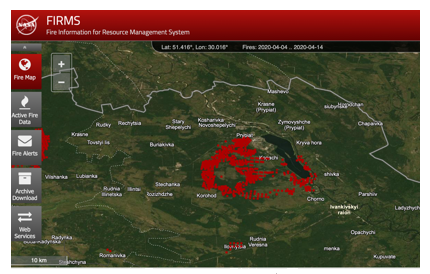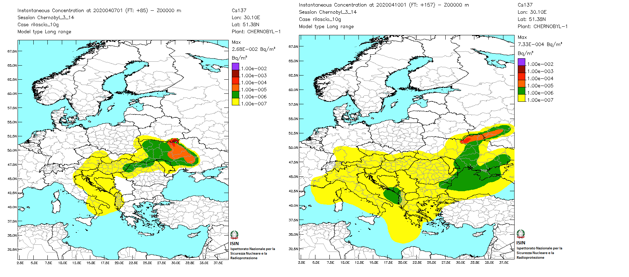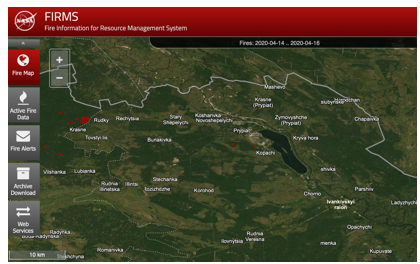Chernobyl, air masses arrived in Italy from Ukraine but radioactivity is irrelevant.

Chernobyl, air masses arrived in Italy from Ukraine but radioactivity is irrelevant.
The forecasts made by ISIN of the diffusion of air masses containing radioactivity from Ukraine, indicating the possible involvement of a large part of the European territory, estimate that the concentration levels of Cesium-137 expected in the atmospheric particulate have not no relevance from a radiological point of view and are such that they do not constitute any health risk for humans and impact on the environment.

Simulation with the ARIES system of the ISIN Nuclear Emergency Center: a) alleged arrival of traces of contamination from Cesio-137 on Italian territory in the early hours of April 7. b) situation of the concentration in the air of Cesium-137 on 10 April.
A study published in these days by the IRSN, the French Institute for Radiological Protection and Nuclear Safety (https://www.irsn.fr/EN/newsroom/News/Documents/IRSN_Information-Report_Fires-in-Ukraine-in-the-Exclusion-Zone-around-chernobyl-NPP_15042020.pdf) reported the results of the models that simulate the trend of the concentration of radioactivity in the air in its evolution in the European region. The study states that a significant part of the European territory may have been affected by the passage of the air masses that come from the fire area.
At the link https://www.irsn.fr/EN/newsroom/News/Pages/20200415_Fires-in-Ukraine-in-the-Exclusion-Zone-around-chernobyl.aspx is also available a video with the whole evolution produced in the study.
To date, no anomalous radioactivity values attributable to the events in Ukraine have been measured by the Laboratories of the regional Agencies and the autonomous Provinces for the protection of the environment and of the Experimental Zooprophylactic Institutes, which constitute the National Surveillance Network of Environmental Radioactivity (RESORAD) which, with the technical coordination of ISIN, is entrusted with the task of checking the possible presence of anomalous levels of radioactivity in the environment.
It should be noted that the concentrations of Cesio-137 estimated by the mathematical models are so low (therefore, it is reaffirmed, completely irrelevant to health) that being able to measure them can represent an arduous task even for the sophisticated high sensitivity instruments of which the laboratories of the RESORAD Network are equipped.
Regarding the fire situation, the State Emergency Service of Ukraine announced yesterday morning that the fires in the Exclusion Zone, which extends up to 30 km around the Chernobyl Nuclear Power Plant, have been extinguished and there are no outbreaks discovered; the intervention teams operate on the burning residues of the fires. However, yesterday afternoon, strong gusts of wind hampered the operations and, in the Exclusion Zone, three new outbreaks appeared consisting essentially of embers and burning embers, which however did not cause particular concern.
The marked improvement in the fire situation in the Exclusion Zone can also be found in the maps obtained from the NASA-FIRMS website (https://firms.modaps.eosdis.nasa.gov/map/#z:2;c:16.0,-6.3 d: 2020-04-15..2020-04-16).

Fig. 1 - Map of fires in the Exclusion Zone area from 4 to 14 April

Fig. 2 - Map of fires in the Exclusion Zone area from 14 to 16 April
The forces deployed by the Ukrainian authorities in recent days have seen the intervention of over 1000 people and 120 vehicles, including 2 air units and 3 helicopters. Some estimates indicate that the area affected by the fires is about 20,000 hectares.
The State Nuclear Regulatory Inspectorate of Ukraine, the Ukrainian Nuclear Safety Authority, said that measurements carried out on Ukrainian territory, particularly in the Kiev region, indicate that, outside the Exclusion Zone, the event did not result in significant radiological consequences for the population and the environment and that the environmental radiological background has remained almost unchanged compared to the existing one.
In the city of Kiev, the highest measured concentrations of Cesium-137, the radioisotope present in the ecosystem in larger quantities and with greater volatility characteristics, remained at very low levels, almost always below 1 mBq / m3 which, if compared with the usual bottom of about 6 microBq / m3, it constitutes the evidence of the passage of contaminated air, albeit slightly.
These concentrations, even in the most conservative hypotheses that can be formulated (e.g. persistence of the maximum concentration for the entire duration of the fires, presence of Strontium-90, the other radioisotope present in the environment following the accident of Chernobyl) are several tens of thousands of times lower than the dose limit for the population: therefore they do not pose a health hazard and have no radiological relevance.
